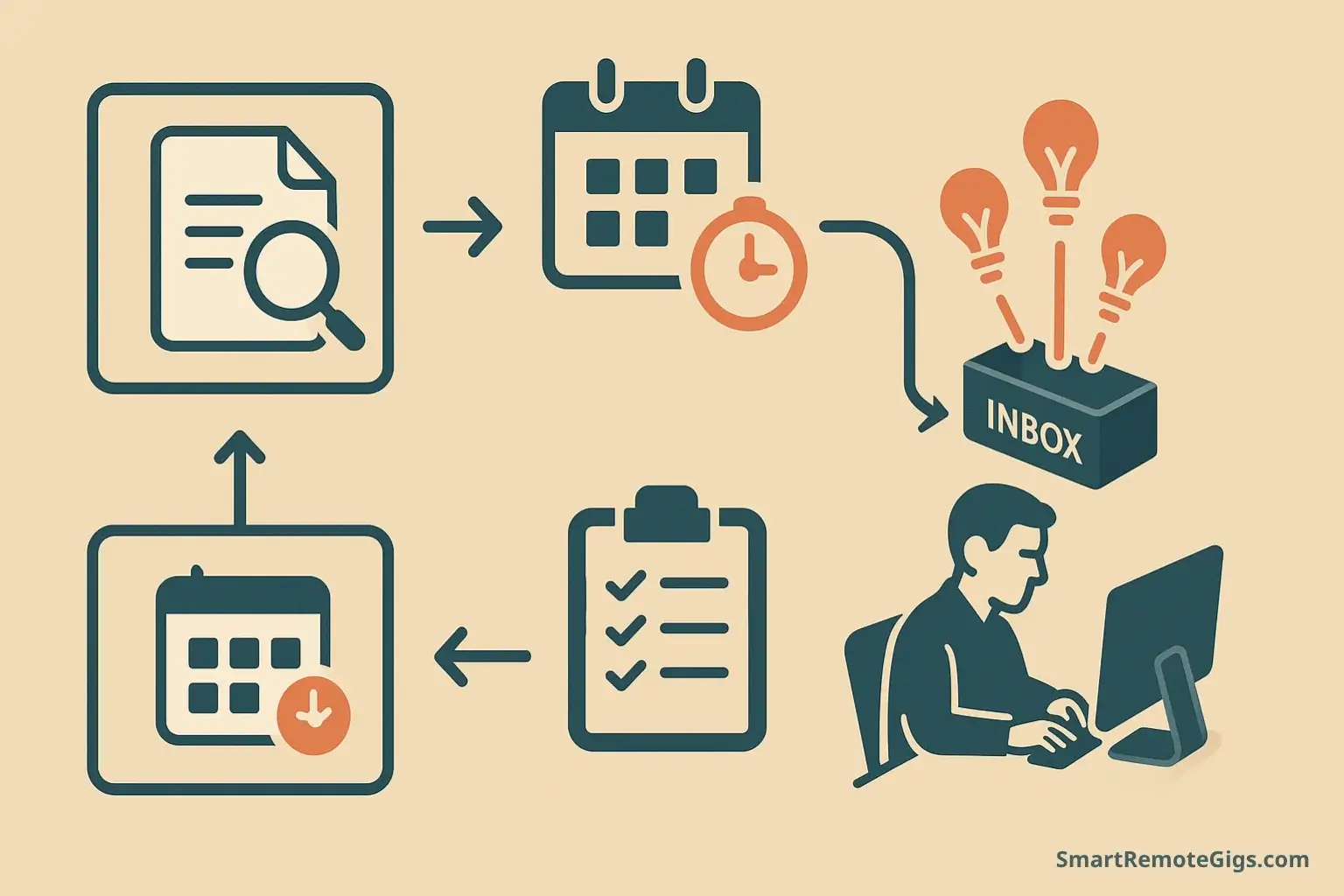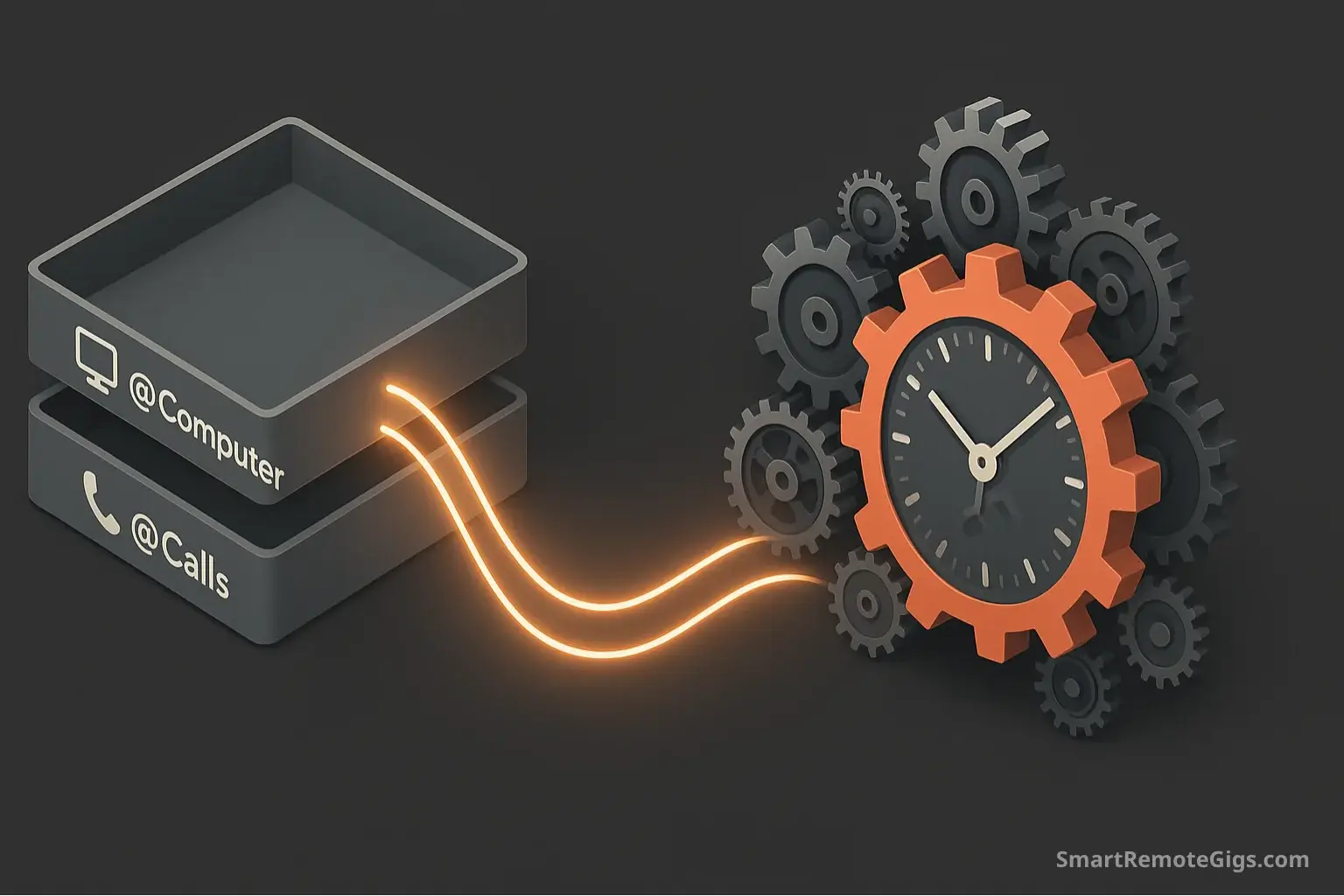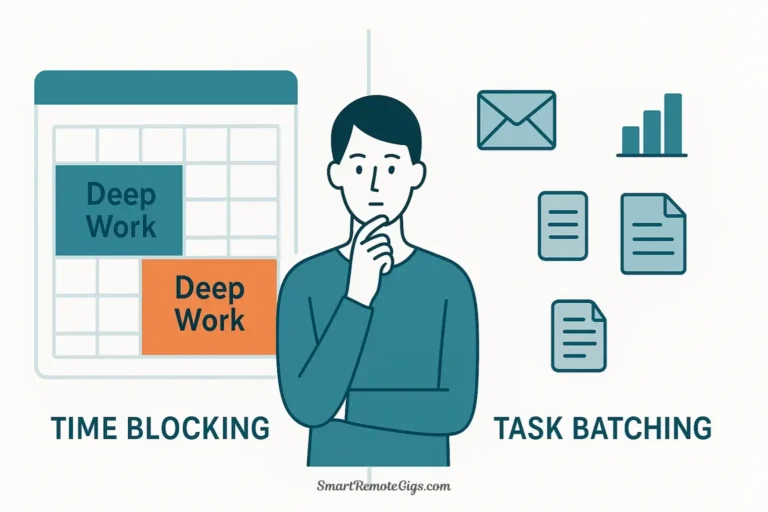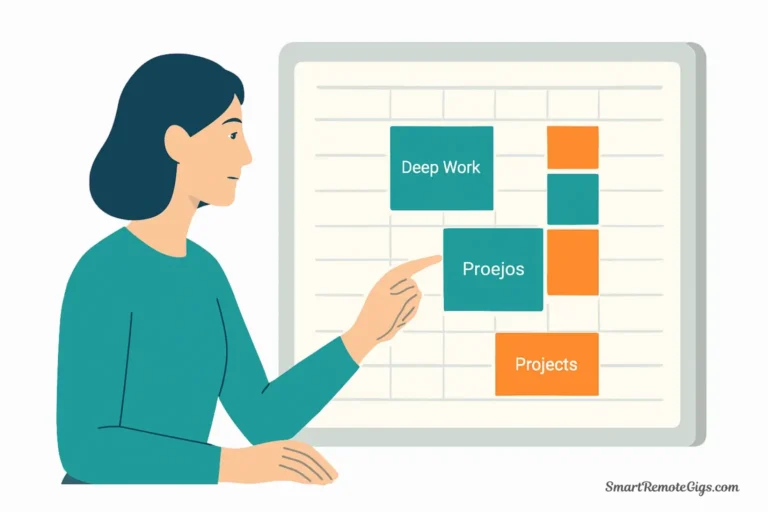You’ve mastered Getting Things Done. Your inbox is at zero, your projects are clearly defined, and your context lists are pristine. You’ve also experienced the focused power of the Pomodoro Technique—those intensely productive 25-minute sessions that eliminate distraction and create momentum.
But here’s what you’ve probably discovered: GTD excels at the “what” while Pomodoro dominates the “how.” GTD gives you crystal-clear visibility into your commitments and next actions, but it doesn’t solve the execution challenge of actually doing the work. Pomodoro provides the focused execution engine, but it doesn’t help you choose what to focus on or ensure you’re working on the right things.
The result? You might find yourself with perfectly organized lists that you struggle to act on, or intense focus sessions spent on tasks that don’t move your most important projects forward. Sound familiar?
Integrating Pomodoro with GTD creates a complete productivity system that bridges this gap. You get GTD’s comprehensive capture and organization combined with Pomodoro’s relentless execution focus. The clarity of your next actions meets the power of timeboxed concentration.
This integrated approach is also a powerful solution to some of the most common Pomodoro mistakes, such as working on low-impact tasks or struggling to define your work sessions.
This isn’t about casually using both techniques—it’s about creating a systematic workflow where each method amplifies the other’s strengths. If you’re new to either approach, we recommend mastering the fundamentals first with our Pomodoro Technique Guide and David Allen’s official GTD resources.
For productivity pros ready to take their systems to the next level, here’s your step-by-step integration guide.
The Perfect Partnership: Why GTD and Pomodoro Are Better Together

The magic happens when you understand that GTD and Pomodoro solve different productivity problems perfectly:
GTD’s Superpower: Eliminating Mental Overhead
GTD ensures that you never waste mental energy wondering what to do next. Your externalized system holds all your commitments, and your next actions are pre-decided during your weekly review. This cognitive clarity is essential—you can’t focus deeply if part of your mind is occupied with remembering or deciding what to work on.
Pomodoro’s Superpower: Eliminating Execution Friction
Pomodoro transforms the abstract concept of “doing work” into concrete, manageable time containers. The timer creates urgency, the boundaries prevent overwhelm, and the rhythm of work and rest maintains sustainable energy. This execution power is crucial—knowing what to do means nothing if you can’t consistently do it.
The Integration Effect: Compound Productivity
When you combine these systems, you eliminate both the “what should I do?” paralysis and the “how do I actually do it?” resistance. Your GTD system feeds your Pomodoro sessions with pre-clarified, appropriately-sized actions. Your Pomodoro rhythm ensures consistent progress on your GTD projects while maintaining the trusted system that keeps everything organized.
This integration also solves common problems with each individual system:
- GTD without execution structure often leads to endless list-making without proportional action
- Pomodoro without clear priorities can result in busy work that doesn’t advance meaningful outcomes
- Both systems together create a feedback loop where better organization enables better focus, and better focus validates the value of staying organized
The 4-Step Integration Workflow

This systematic approach ensures that your GTD foundation properly supports your Pomodoro execution, creating a seamless workflow from capture to completion.
Step 1: Clarify Your Next Actions (The GTD Part)
The foundation of successful integration is ensuring your GTD next actions are naturally Pomodoro-compatible. This requires more precision in your action definition than standard GTD practice.
The “One Pomodoro Rule” for Next Actions:
Every next action should be completable within 25 minutes or clearly represent 25 minutes of meaningful progress on a larger task. This isn’t about artificially constraining your work—it’s about creating natural stopping and starting points that align with focused work sessions.
Examples of Pomodoro-Compatible Next Actions:
❌ Too Vague: “Work on quarterly report”
✅ Pomodoro-Ready: “Draft executive summary outline for Q3 report (5 key points)”
❌ Too Large: “Research competitor analysis”
✅ Pomodoro-Ready: “Gather Q3 financial data for top 3 competitors”
❌ Unclear Scope: “Update website”
✅ Pomodoro-Ready: “Write copy for About Us page (500 words max)”
The Two-Minute Rule Adaptation:
In standard GTD, tasks under two minutes should be done immediately. With Pomodoro integration, consider batching these micro-tasks into dedicated “Administrative Pomodoro” sessions rather than breaking your focused work flow.
Multi-Pomodoro Project Breakdown:
For larger projects, break them into a sequence of Pomodoro-sized actions during your weekly review:
- Action 1: Research phase (1 Pomodoro)
- Action 2: Create initial draft (2 Pomodoros)
- Action 3: First revision pass (1 Pomodoro)
- Action 4: Incorporate feedback (1 Pomodoro)
Step 2: Assign Pomodoro Estimates During Your Weekly Review
Transform your weekly review into a strategic session that not only organizes your commitments but also creates a realistic execution plan.
The Estimation Process:
As you review each next action, add a Pomodoro estimate tag:
- @1p = One Pomodoro (25 minutes)
- @2p = Two Pomodoros (50 minutes with break)
- @3p = Three Pomodoros (extended session or spread across multiple times)
Estimation Guidelines:
- Familiar tasks: Trust your experience but err slightly conservative
- New or complex tasks: Add 25-50% buffer to your initial estimate
- Creative work: Often benefits from longer estimates to account for thinking time
- Administrative work: Usually fits well in standard Pomodoro timeframes
Weekly Capacity Planning:
Calculate your realistic weekly Pomodoro capacity:
- Deep work sessions per day × working days = weekly capacity
- Subtract 20% for unexpected interruptions and energy fluctuations
- Use this number to guide your weekly commitments
Sample Weekly Review Addition:
Standard GTD: “Call client about project timeline”
Integrated approach: “Call client about project timeline @1p [Calls context list]”
Step 3: Choose Your Daily Pomodoros from Your Context Lists
Your daily planning becomes a strategic selection process rather than reactive task-switching. This step bridges your weekly organization with your daily execution.
The Daily Selection Criteria:
- Energy matching: Choose demanding tasks for your peak energy periods
- Context optimization: Group similar tasks to minimize mental context switching
- Project advancement: Ensure each day moves your most important projects forward
- Realistic capacity: Don’t overcommit your available Pomodoro slots
Sample Daily Planning Process:
- Review your calendar for fixed commitments
- Identify available Pomodoro slots (typically 4-8 per day)
- Select high-priority actions from appropriate context lists
- Sequence them based on energy levels and logical flow
Context List Examples with Pomodoro Integration:
- @Computer: “Update client database @1p” and “Respond to proposal emails @1p”
- @Calls: “Schedule team meeting @1p” and “Follow up with vendor @1p”
- @Creative: “Design homepage mockup @2p” and “Brainstorm campaign ideas @1p”
The “Pomodoro Buffer” Strategy:
Always select 1-2 more Pomodoros than you think you can complete. This prevents the end-of-day productivity drop when you finish your planned work early but don’t know what to do next.
Step 4: Execute with Pomodoros, Capture with Your Inbox
The execution phase requires maintaining GTD’s capture discipline within Pomodoro’s focus structure. This prevents the common problem of breaking focus to handle new inputs while ensuring nothing falls through the cracks.
The “Focus First, Process Later” Protocol:
During active Pomodoro sessions:
- New inputs (emails, ideas, requests) go directly into your GTD inbox
- No processing of these inputs during work time
- No exceptions—even “quick” responses break focus and reduce session effectiveness
Capture Tools During Pomodoro Sessions:
- Physical inbox: Notebook or paper for quick thoughts
- Digital inbox: Single app or location for all inputs
- Voice notes: For ideas that come while walking during breaks
- Browser bookmarks folder: “To Process” folder for interesting links
Common Execution Challenges and Solutions:
Challenge: “But this email seems urgent…”
Solution: Add “URGENT: [brief description]” to your inbox. Process during your next inbox-clearing session, not during focused work time.
Challenge: “I just had a great idea for another project…”
Solution: Capture it immediately in your inbox with enough detail to remember later, then return to your current focus immediately.
Challenge: “This task is taking longer than estimated…”
Solution: Complete the current Pomodoro, take your break, then decide whether to continue or reschedule. Don’t extend sessions arbitrarily.
Post-Pomodoro Processing:
At natural transition points (lunch, end of workday), spend 5-10 minutes processing your inbox according to standard GTD workflow. This maintains system integrity without interrupting focus sessions.
For a full rundown of tools that integrate directly with GTD systems like Todoist and Asana, see our review of PomoDone in the Best Pomodoro Timer Apps guide.
A Practical Example: Writing a Report with Pomodoro + GTD

Let’s see how this integrated workflow handles a complex, multi-step project from capture to completion.
Initial Capture:
During your weekly review, you identify: “Write quarterly performance report for board meeting”
GTD Project Planning:
Project: Q3 Performance Report for Board
Outcome: Professional report delivered to board members 48 hours before meeting
Next Actions Sequence:
- Gather Q3 financial data from accounting system @1p [Computer]
- Compile customer satisfaction survey results @1p [Computer]
- Create report outline with 6 main sections @1p [Computer]
- Draft executive summary (300 words) @1p [Computer]
- Write financial performance section @2p [Computer]
- Write customer insights section @2p [Computer]
- Write operational highlights section @1p [Computer]
- Create supporting charts and graphs @2p [Computer]
- First editing pass for clarity and flow @1p [Computer]
- Format report according to board template @1p [Computer]
- Final proofread and polish @1p [Computer]
Daily Execution Planning:
Monday: Actions 1-3 (3 Pomodoros during morning peak energy)
Tuesday: Actions 4-6 (4 Pomodoros with lunch break between sections)
Wednesday: Actions 7-9 (3 Pomodoros)
Thursday: Actions 10-11 (2 Pomodoros, leaving buffer time for revisions)
Sample Execution Day (Tuesday):
- 9:00-9:25: Draft executive summary @1p
- 9:25-9:30: Break (walk, hydrate)
- 9:30-10:20: Write financial performance section @2p (with 5-minute break at 9:55)
- 10:20-10:30: Process inbox items that came in during work time
- 10:30-11:20: Write customer insights section @2p (with break at 10:55)
Integration Benefits in This Example:
- Clear project scope prevents scope creep during execution
- Pomodoro estimates enable realistic timeline planning
- Context grouping (all @Computer) minimizes setup time
- Inbox capture during sessions maintains focus without losing inputs
- Progress tracking validates both the GTD breakdown and Pomodoro effectiveness
Advanced Tips for Power Users

Once you’ve mastered the basic integration, these advanced techniques can further optimize your system for maximum effectiveness.
Using Pomodoros for Your GTD Weekly Review
Transform your weekly review from a potentially overwhelming admin session into a series of focused, manageable work blocks:
Weekly Review Pomodoro Breakdown:
- Pomodoro 1: Inbox to zero (emails, notes, voice memos)
- Pomodoro 2: Process project lists and identify stalled projects
- Pomodoro 3: Review and update next action lists
- Pomodoro 4: Calendar review and upcoming week planning
- Pomodoro 5: Add Pomodoro estimates to newly clarified actions
This approach ensures your weekly review gets done consistently while preventing the “marathon review session” that many GTD practitioners struggle with.
Handling Multi-Pomodoro Tasks
Some work naturally requires longer sustained attention than a single 25-minute session. Here’s how to handle these within your integrated system:
The “Pomodoro Sequence” Approach:
Instead of one large action, create a sequence:
- “Research competitor pricing @3p” becomes:
- “Gather competitor pricing data @1p”
- “Analyze pricing patterns and trends @1p”
- “Create pricing comparison summary @1p”
The “Extended Session” Protocol:
For work that genuinely benefits from longer focus (deep analysis, creative work), use the extended Pomodoro approach:
- Plan 45-50 minute sessions with 10-15 minute breaks
- Mark these as “@2p+” in your system
- Use sparingly—reserve for your most important deep work
Energy and Context Optimization:
- Schedule multi-Pomodoro tasks during your peak energy periods
- Minimize context switching between related Pomodoros
- Prepare everything needed before starting the sequence
- Plan appropriate break activities that support sustained focus
Conclusion: From Organized to Accomplished
The integration of Pomodoro and GTD represents more than just using two productivity techniques—it’s about creating a complete system that honors both the complexity of modern work and the reality of human attention.
GTD ensures you’re working on the right things by capturing everything, clarifying outcomes, and organizing actions by context. Pomodoro ensures you actually do the work by providing structure, focus, and sustainable rhythm. Together, they create a productivity system that is both comprehensive and executable.
The key to successful integration isn’t perfection—it’s consistency. Start with the basic four-step workflow, gradually incorporating the advanced techniques as they become natural. Your system will evolve as you discover what works best for your specific work patterns and priorities.
Remember that this integrated approach serves a higher purpose: creating more time and mental space for the work that matters most to you. When you eliminate the friction between planning and doing, you free up cognitive resources for creativity, strategic thinking, and meaningful contribution.
Your next step is simple: choose one project from your current GTD system and apply the integrated workflow. Break it into Pomodoro-sized actions, add time estimates, and execute with focused sessions. Notice how the clarity of your planning enhances your focus, and how the success of your focused execution validates the value of your organizational system.
From organized lists to accomplished outcomes—that’s the power of Pomodoro and GTD working together.

This guide provides a 4-step integration workflow to combine the organizational power of Getting Things Done (GTD) with the execution focus of the Pomodoro Technique, creating a complete productivity system.
Total Time: 2 hours
Clarify Your Next Actions (The GTD Part)
Ensure your GTD next actions are Pomodoro-compatible. Every next action should be completable within 25 minutes or represent 25 minutes of progress. Break down larger projects into a sequence of Pomodoro-sized actions.
Assign Pomodoro Estimates During Your Weekly Review
Transform your weekly review into a strategic planning session. As you review each next action, add a Pomodoro estimate tag (e.g., @1p for one 25-minute session) to create a realistic execution plan.
Choose Your Daily Pomodoros from Your Context Lists
Your daily planning becomes a strategic selection process. Review your calendar, identify available Pomodoro slots, and select high-priority actions from your GTD context lists, matching demanding tasks with your peak energy periods.
Execute with Pomodoros, Capture with Your Inbox
Maintain GTD’s capture discipline within Pomodoro’s focus structure. During active Pomodoro sessions, all new inputs (emails, ideas, requests) go directly into your GTD inbox for later processing. This maintains focus without losing valuable information.
Tools:
- A GTD system (e.g., Todoist, Asana, Notion)
- A Pomodoro timer
- A digital or physical inbox for capturing tasks
- A calendar for planning







There’s a meditative cadence to your sentences. Each pause feels deliberate, allowing reflection to settle and meaning to expand naturally in the reader’s mind.
Thank you so much for your incredibly thoughtful feedback! I’m so glad the pacing and style resonated with you. That’s exactly what I was aiming for.